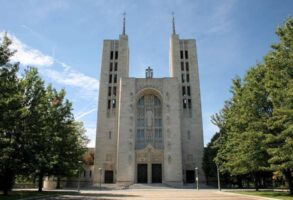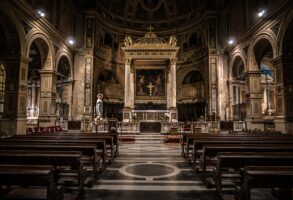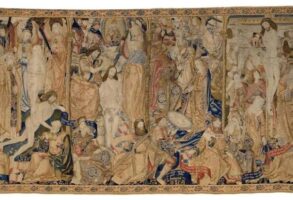Published September 17, 2015
In a few days Pope Francis will make his first visit to the United States. He will meet President Obama. He will address a joint session of Congress (something no pontiff has ever done). He will give an address to the United Nations in New York. Every word of his, scripted and unscripted, will be parsed for its political significance. Every gesture will be studied, scrutinised and spun. Cranks will complain, pundits will opine. The Holy Father’s visit is being treated with all the hype and gamesmanship of a major political campaign event.
And that, in part, is understandable. This visit – this Pope visiting at this particular time – ought to be big news, and it will necessarily disturb the already turbulent waters of American politics.
Experience suggests that Pope Francis is unlikely to steer completely clear of neuralgic political issues. He doesn’t mind causing a ruckus now and then. But his is an apostolic visit – he comes as an apostle, a messenger, a successor of Peter. He visits as a pastor, first and foremost, and Catholics must not forget this, even if everyone else does.
Francis comes at a critical time for the Church in the United States, and for the 70 million or so Catholics who live in the country. The Church’s future is filled with promise and doubt, hope and confusion, division and resilience. The self-inflicted wounds of the sexual abuse crisis are far from healed, yet the Church here has dealt with the scourge better than almost any institution in the world.
American Catholics face many of the same evangelical and catechetical challenges as the rest of the developed world – a rising secular tide, the spiritual lukewarmness that comes so easily to affluent cultures, along with consumerism, relativism and individualism. Yet Americans stubbornly remain more religiously observant than their European counterparts.
The US has one of the most permissive abortion regimes in the world, and yet its pro-life movement is second to none.
Catholic institutions remain a vital part of the social fabric of the nation. Yet these same institutions – hospitals, universities, hospices, soup kitchens, homeless shelters, adoption agencies, businesses and all manner of social service providers – are increasingly being given this choice: abandon the Church’s teaching on human sexuality or pay the price.
If Pope Francis likes a Church that gets messy – that isn’t afraid to be “bruised, hurting and dirty” for having been out in the street – then he should like much of what he finds when he comes to the United States. In fact, while it is easy to hear many of the Pope’s sharp criticisms of, say, trickle-down economics or income inequality as being directed toward the United States, there is a great deal about American Catholicism that already exemplifies the kind of Church Francis has been calling for since he was elected.
The willingness of Americans to speak our minds, prudently or otherwise, when we think we are in the right is Exhibit A. The Pope, after all, has repeatedly encouraged Catholics not to hold their opinions back. But say what one will of American vociferousness, during the pontificate of Francis it has been comparatively restrained.
Every bishop and priest in the United States knows from experience just how emphatic American Catholics can be in our opinions – considered or otherwise – about how things ought to be done. While this outspokenness has its advantages, it has a downside, too. When he visited the United States in 2008, Benedict XVI saw this with particular clarity: heightened individualism can reduce our shared belief to the “lowest common denominator”.
He said: “This is aggravated by an individualistic and eclectic approach to faith and religion: far from a Catholic approach to ‘thinking with the Church’, each person believes he or she has a right to pick and choose, maintaining external social bonds but without an integral, interior conversion to the law of Christ. Consequently, rather than being transformed and renewed in mind, Christians are easily tempted to conform themselves to the spirit of this age. We have seen this emerge in an acute way in the scandal given by Catholics who promote an alleged right to abortion.”
This is as succinct a diagnosis as you are likely to find of one of the most fundamental challenges facing the Church in the United States. And while Pope Francis is less likely to cite pro-abortion Catholics as the diagnostic indicator, he has repeatedly taken up Benedict’s critique of relativism, tying it directly to the “throwaway culture”, most recently in his environment encyclical Laudato Si’.
The American Church – the American episcopate in particular – has been steadfast in its opposition to those aggressors in the “culture wars” who demand complicity in the regnant moral relativism, particularly when it comes to sexual matters. Ongoing American fights over religious freedom are not simply about employer-provided contraceptives or same-sex marriage; they are struggles over whether the Church will be allowed her rightful place in society, free to provide for the material and spiritual needs of the people in accordance with the truth.
In short, the Church defends religious freedom because social justice and the common good depend on it. The Obama administration apparently disagrees, which is why the Little Sisters of the Poor, who provide hospice care for the aged and dying, have been spending so much time in federal court recently.
Speaking of social justice and the common good, another arena in which the Church in America is exemplary is in her charitable and philanthropic work. Catholic Relief Services provided almost $600 million in 2014 to assist some 85 million people worldwide, making it one of the largest member organisations in Caritas Internationalis.
Catholic Charities USA is the largest private provider of social services in the country. The services offered by its networks amounted to almost $4 billion last year alone. The 549 Catholic hospitals in America served almost 90 million patients in 2014, while nearly two million students attended the more than 6,500 Catholic elementary and secondary schools. Catholic schools have an especially worthy history of not just educating poor and immigrants but also serving as a means of social integration.
Perhaps none of this is worth boasting about. Much of what gets described as “charity” is, after all, given as a matter of justice: “Every one to whom much is given, of him will much be required.” What is remarkable, however, is the degree to which these organisations and activities originated and largely operate independently from government. That’s not evidence of some high-minded disdain for government but a testament to the vitality of American civil society. Americans are habitual, relentless organisers.
A prime example of this is the pro-life movement. Every January since 1974, through snow and bitter cold, Americans have come to March for Life on the anniversary of the Supreme Court decision that legalised abortion. Now the gathering is regularly attracting 100,000 people or more.
The pro-life movement has also been an occasion for ecumenical cooperation. Catholics, Protestants, Jews, Muslims and others have found common cause, and common ground, in the defence of human life.
Critics will say that, for all the marching, organisation and effort, all that has been accomplished in 42 years is deeper political division. The abortion license has been rolled back only at the margins. But ask any pro-life activist from outside the US, and they will tell you that the degree of organisation, enthusiasm, resilience and sheer size of the American pro-life movement is
a marvel.
Thousands of crisis pregnancy centres operate across the country – two centres for every abortion clinic, by some counts. These centres counsel women with difficult or unwanted pregnancies about alternatives to abortion. They are equipped with ultrasound machines so mothers can hear their baby’s heart beat and see their little arms and legs.
Pope Francis recently announced that, for the Jubilee of Mercy, all priests will have the faculty to not only forgive the sin of abortion but also to lift any canonical penalties at the same time. This has already been the norm in America for decades.
If ever a reminder was needed of the woundedness and sin that can infect the Church, one need look no further than the abuse crisis that has rocked the Church in the United States. But even here, amid the filth and betrayal, the American Church can serve as an example to others. Nowhere has the response to the abuse of children been more thorough or successful than in the US. That is not to say the work is done or that the self-inflicted wounds have healed – neither is true – but the safeguards put in place by the bishops have been overwhelmingly effective.
The long process of healing has begun and the slow work of restoring credibility and trust is underway. It was no coincidence that Pope Francis chose an American – Cardinal Seán O’Malley of Boston, a city profoundly affected by the crisis – to lead the newly created Pontifical Commission for the Protection of Minors.
As in many other nations in the developed world, the United States saw the number of priests fall dramatically after Vatican II. Ordinations are down roughly 40 per cent since 1970. But the good news is that the numbers of both seminarians and ordinations have been climbing slowly since the mid-1990s. This trend continued even through the worst of the abuse
scandals.
A more severe vocations crisis, albeit one much less widely noted, lies in the even more dramatic collapse in the number of Catholic marriages. In 1970, there were some 426,000 marriages celebrated in Catholic churches in America, according to the Centre for Applied Research in the Apostolate at Georgetown University. Since then, while the Catholic population has grown by almost 40 per cent, the number of Catholic marriages has plummeted. Last year there were 154,450 Catholic weddings, a drop of 64 per cent. If there is an answer to the marriage crisis, it has yet to be found.
The Pope’s visit coincides with the World Meeting of Families in Philadelphia and, of course, the family synod will convene in Rome just days after the Holy Father returns there. Some of the reforms to the annulment process Francis has already announced may make annulments in other countries more accessible and efficient – something the US has been the world leader in for years. (Not that that’s a point of pride, exactly.)
The Pope is likely to warn his American flock of the dangers of worldly comforts and the obligations of wealth. He may well urge them to remember the Lord’s words: “The last will be first, and the first will
be last.”
Yet in America he will discover a Church that, for all its maddening diversity, has a great deal to offer Catholics worldwide. Catholicism, it is often said, is not a religion of “either/or” but of “both/and”. At its best, US Catholicism strives to be both faithful to the teachings and doctrines of the Church and a vivid example of Christian love in action. In that regard, Pope Francis should feel right at home.
One last thought: the second reading for the 26th Sunday in Ordinary Time – when Pope Francis will celebrate Mass for a million or more people in Philadelphia – comes from the fifth chapter of James. It begins: “Come now, you rich, weep and wail over your impending miseries.”
That homily should be memorable.
Stephen P White is a fellow in the Catholic Studies Programme at the Ethics and Public Policy Centre in Washington DC.









